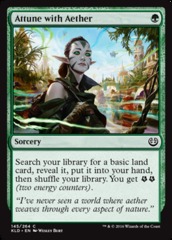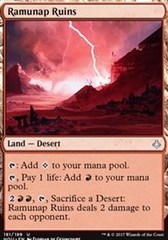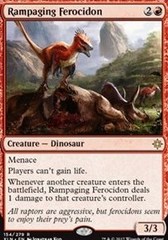Fighting the Format: Banning Special

Well, my plans to continue the pieces on RIX spoilers got quashed. Welcome to another Fighting the Format special – this time, we’re looking at the newest wave of Standard bans.
Kaladesh. You’re a pretty unique plane, and thematically a slam-dunk; if anyone can tell me with a straight face they’re not into pseudo-Indian steampunk 1984 big-brother world, I’ll tell them they’re a liar. Mechanically, you introduced such Standard mainstays as Chandra, Torch of Defiance, Torrential Gearhulk, and Heart of Kiran. These are all pushed, flashy cards, but they are by no means dominating the format. For that, we love you.
You are also almost single-handedly responsible for the biggest shake up Standard has even seen, with repeated bannings to reduce your stranglehold on the format. For that, we loathe you.
Smuggler’s Copter, Felidar Guardian, and Aetherworks Marvel all had the format by the throat at one time or another, and as the banhammer works it’s way through the greatest hits of your design mistakes, we reach the most innocuous of your works. The backbone of the strongest and individually parasitic mechanic to reach player’s hands in years: Energy.
The Bans

When Lay of the Land is seeing a Standard ban, you know someone done goofed.
Attune with Aether was public enemy number #1 in the minds of players everywhere, as it effectively did three things: cantripping, mana fixing, and providing an untouchable but quite tangible extra resource.
By replacing itself with a land, Attune cost it’s caster nothing but a single Green mana. By searching up any basic, it fixed mana bases, along with it’s dastardly partner in crime Aether Hub. Lastly, it provided two Energy, which could later turn into any number of other resources, whether counters on Longtusk Cub and Bristling Hydra, Thopters from Whirler Virtuoso, cards from Glint-Sleeve Siphoner or damage from Harnessed Lightning.
Attune cost the caster almost nothing, and provided Energy decks with an uninteractive resource non-Energy decks don’t have access to. For that reason, it’s out.

The card that tied the Energy decks mid and long game together, Rogue Refiner echoes Attune in it’s versatility. For 1UG, you get a body, a card, and two Energy.
At a three mana 3/2, Refiner isn’t exactly beating Rhonas, the Indomitable in an arm-wrestle, but by giving back two resources on resolution, it’s body is justified. A 3/2 may not be trumping five drops all too often, but it’s pretty comfortably trading for two and other three drops, and threatening a good chunk of damage when left unanswered. By giving you back the card, it even allowed Energy decks to keep up with decks designed for the long game – when your UW Control opponent Fumigates your pair of three drops, you should not be happy with the exchange. To top it off, it matches Attune in bringing a pair of Energy for the cause, eventually allowing a Whirler Virtuoso to craft an army of Thopters at will.
All of this for zero card investment? Refiner, out.
Now, with Attune and Refiner gone, Wizards had to look at what would happen to the format. What deck did Temur prey on? What deck was objectively powerful, with a focused game-plan and plenty of tools to work with? What deck had stellar matchups across the board against everything except Temur Energy?

It turns out the Red menace also needed a slap on the wrist, and while there are arguments for everything from Bomat Courier and Hazoret the Fervent to Earthshaker Khenra and Ahn-Crop Crasher, I think we can all agree that Ramunap Ruins is the tool that most effectively diversifies it’s threats. The deck is titled Ramunap Red, after all!
First, let’s look at what Ramunap Ruins offers. By itself, it allows a flooded Red player to Shock the opponent in exchange for a turn of mana, and do so without ever putting a spell on the stack. That is already a powerful effect, if fairly unexciting. With the addition of other Deserts, Ruins turns into an uncounterable deal four, six, or even more to the opponent. Having your opponent effectively start the game at fourteen life is quite the deal!
Okay, we know what Ruins offers you – a wounded opponent before any cards are even dealt. Plenty of Red mages would trade away a number of things for that ability. So, what does it cost? A card, tempo, a restrictive mana base? No, what Ruins costs you is a resource many firebrands forget they even have – life. Ramunap Red couldn’t care less about it’s life total in games that it’s winning, and Ruins ensures that it stays winning. The second thing Ruins encourages you do is include a number of Sunscorched Desert in your deck. Ruins asks a Red deck to play lands that damage the opponent. The horror! Ruins, get out.

The final ban in what is hopefully the last crash of the hammer before Kaladesh’s rotation in September is the most interesting, but also most well thought-out. It’s the second shot at the Red deck, with Rampaging Ferocidon.
The Ferocidon is fairly unassuming on it’s face. It’s certainly a pushed creature, as a three mana 3/3 Menace with upside is wont to be, but it’s not lighting the world on fire. It’s prevention of life gain is pretty common text on rares in the colour, and it’s punishment of creatures is fairly minor. It’s when these three things are combined, and you look at the weaknesses Red decks usually present, that it becomes apparent how much of a problem the clever girl really is.
Red decks are generally defined by three things – small but cheap creatures to get ahead early, a couple of medium haymakers (Dragons and Planeswalkers) to punch through the midgame, and a ton of burn spells to close out before a stable opponent can crack back. The answers to these are pretty straight forward; cheap removal for the early creatures, going wide to blunt both the initial rush and slow or even pressure the haymaker, and life gain to put you out of reach of the burn. Historically, cards like Pharika’s Cure, Hangarback Walker and Thragtusk are where you want to be. Presently, Fatal Push, Moment of Craving and Whirler Virtuoso are your go-to anti-Red cards.
The Ferocidon makes gets around them all. It can’t be killed by Fatal Push, Shock, or Moment of Craving. It punishes Virtuoso and other token makers for going wide. It cannot be chump blocked, demanding two creatures throw themselves in front of it to prevent damage. Finally, it nullifies life gain, switching off big Lifelinkers that would otherwise run away with the game such as Angel of Invention or an army of Vampire tokens from mono-White or Abzan.
Though a lot of this is also true for Hazoret the Fervent, Hazoret is not often racing a 6/6 Angel of Invention, nor is it punching through a board of six Vampire tokens. Ferocidon, door.
With these bans, the usual backlash occurs. Players are concerned with the immediate loss in value of their cards, and the potential future of their collections. Let me assuage these fears – your Hazoret the Fervent, Glorybringer, Chandra and Scarab Gods will still fetch a pretty penny!
While these bans certainly hurt their respective archetypes and open up the Standard field further (very, very much a positive step for the format), the archetypes are going nowhere. I’d venture to say that both Temur Energy and HazoRed (a way better name than ‘Ramunap Red’ ever was, by the way) will stay tier one decks. Don’t unsleeve your Whirler Virtuoso’s and Bomat Couriers – let’s take a look at what both Temur and Red have for us post-ban!
Post-ban Temur
| 26 Creatures | 26 Lands |
| 4 Servant of the Conduit | 4 Aether Hub |
| 4 Longtusk Cub | 4 Botanical Sanctum |
| 4 Whirler Virtuoso | 4 Spirebluff Canal |
| 2 Rhonas, the Indomitable | 3 Sheltered Thicket |
| 4 Bristling Hydra | 3 Rootbound Crag |
| 2 Chandra, Torch of Defiance | 4 Mountain |
| 4 Glorybringer | 4 Forest |
| 2 Ghalta, Primal Hunger | |
| Sideboard | |
| 8 Non-Creature Spells | 2 Nissa, Steward of Elements |
| 2 Magma Spray | 4 Deathgorge Scavenger |
| 4 Harnessed Lightning | 2 Chandra’s Defeat |
| 2 Abrade | 2 Abrade |
| 4 Negate | |
| 1 Supreme Will |
This vision of post-ban Temur leans a little more aggressive and cuts down on the Blue splash, as it’s now lacking the grind of Rogue Refiner and mana consistency of Attune with Aether. I could easily see a build playing Jadelight Ranger as it’s Refiner replacement, or leaning harder into Blue with Vizier of Many Faces or Confiscation Coup.
Post-ban HazoRed
| 30 Creatures | 10 Non-Creatures Spells |
| 4 Bomat Courier | 4 Shock |
| 4 Fanatical Firebrand | 4 Lightning Strike |
| 4 Rigging Runner | 2 Repeating Barrage |
| 4 Daring Buccaneer | |
| 4 Direfleet Daredevil | 20 Lands |
| 3 Kari Zev, Skyship Raider | 20 Mountain |
| 1 Metallic Mimic | |
| 2 Captain Lannery Storm | Sideboard |
| 4 Hazoret the Fervent | 2 Glorybringer |
| 2 Chandra, Torch of Defiance | |
| 3 Pia Nalaar | |
| 3 Aethersphere Harvester | |
| 4 Abrade | |
| 1 Chandra’s Defeat |
This is the red deck I know and love. Sixteen one drops, a bunch of burn spells, and a couple Hazoret to finish them off. It’s worth noting that the stock of Aethersphere Harvester in the sideboard has gone way, way up with the Ferocidon’s banning, so I’m suggesting a full three copies here for the mirror.
Summary
So, there you have it. Temur and Red are still forces to be reckoned with, but hopefully a little less overbearing than the pre-ban Magic Online results demonstrated. As the next PT is Modern, we’ve all got some time to enjoy Standard once again, and have it be shaped by us mere mortals before PT Dominaria. Get on your brewing hats and venture forth!
Next week, I’ll be back on schedule with a look at some Vamps or Dinos, and may even have some current Standard results to work with. In the meantime, if you’ve got any thoughts, comments, or even new decklists to share, please do so in the comments. As always, thanks for reading, and good luck.





